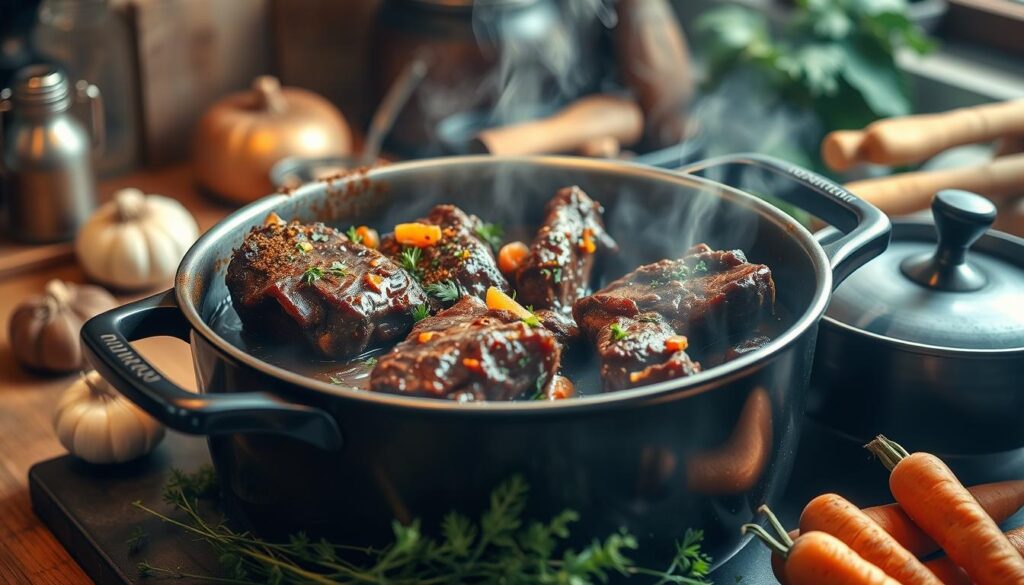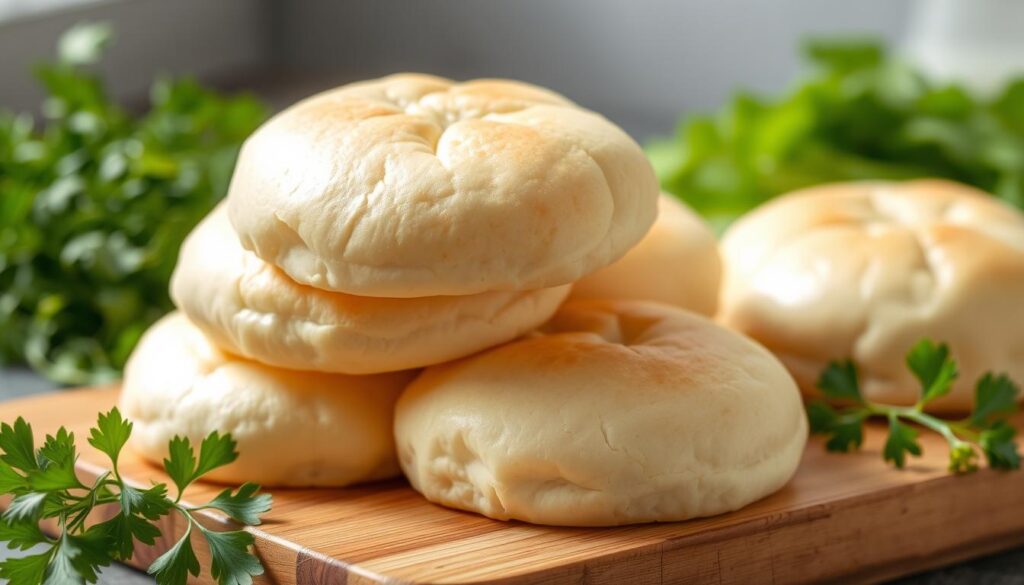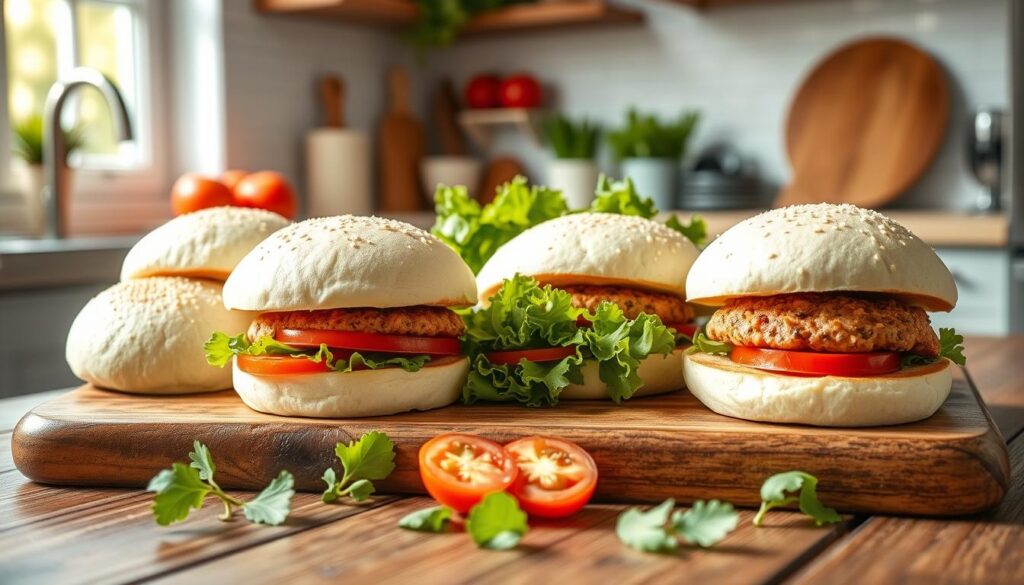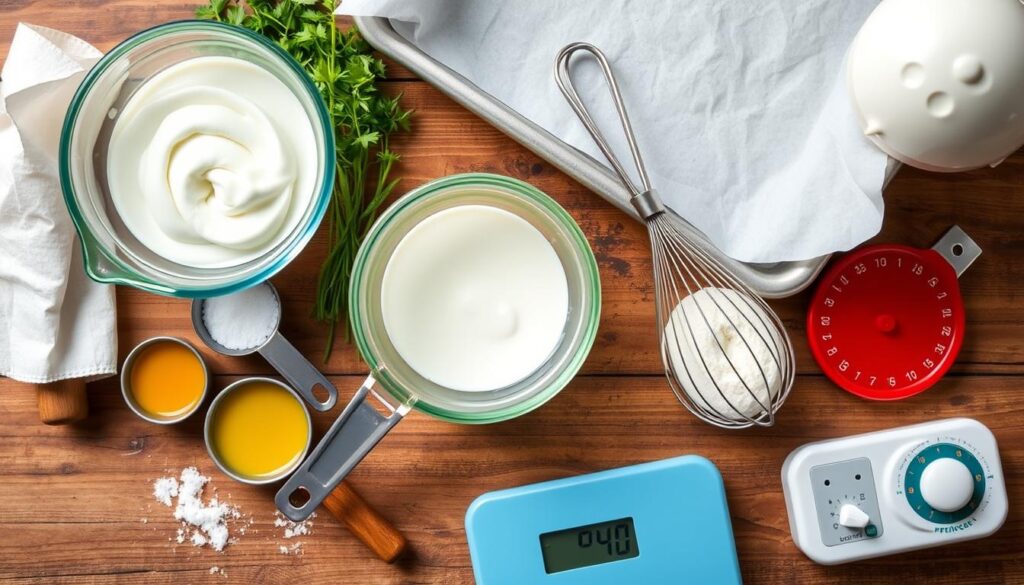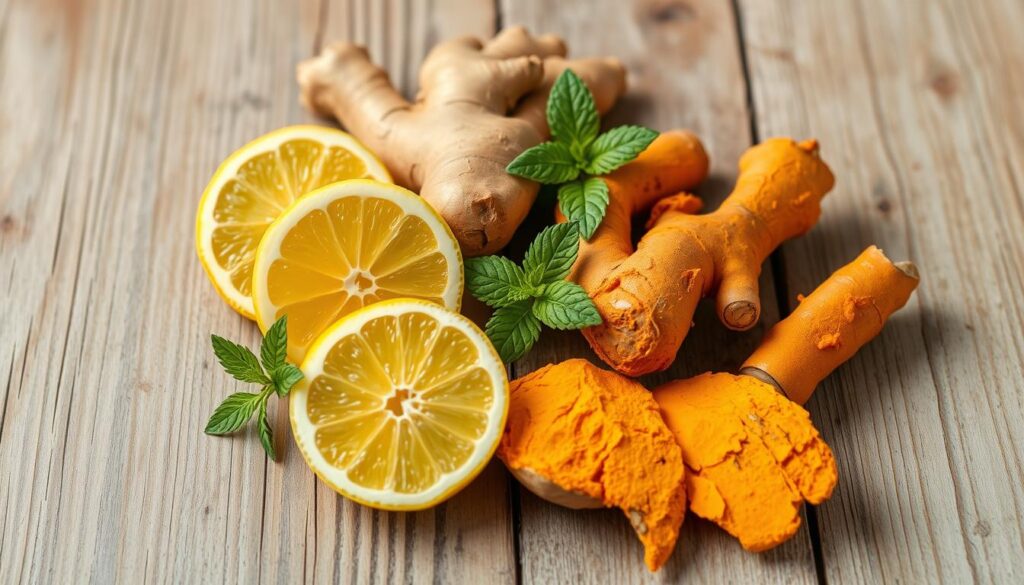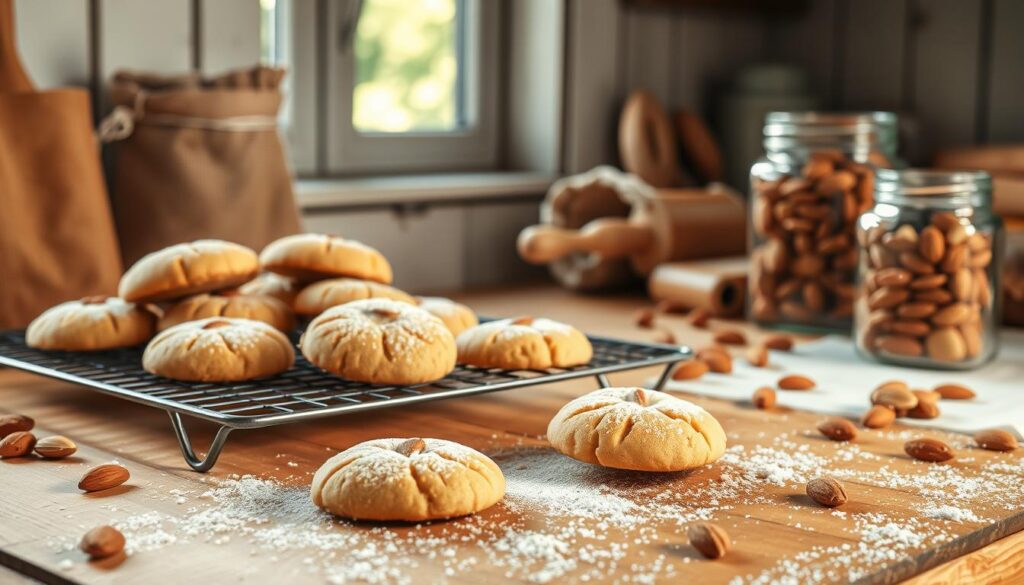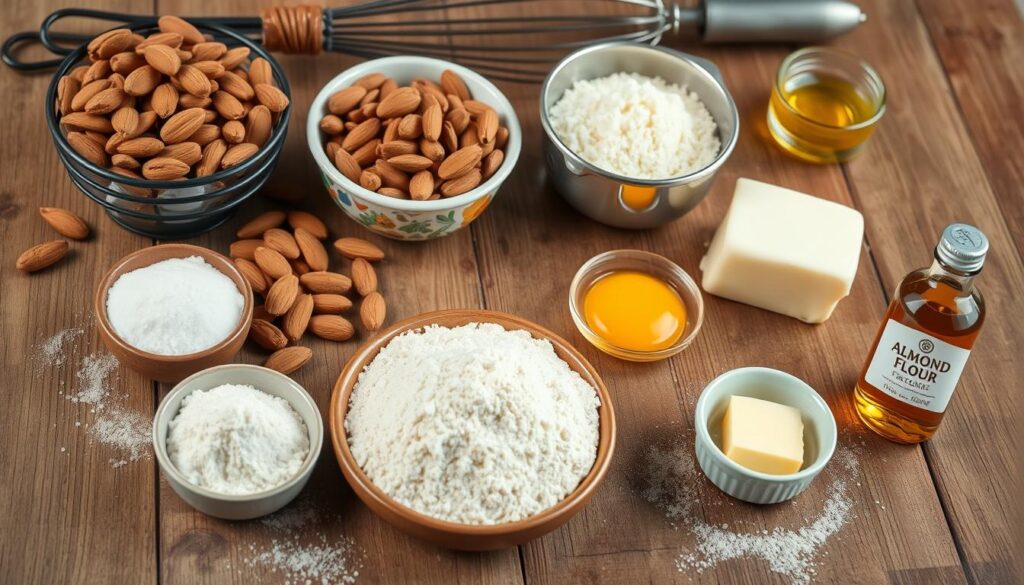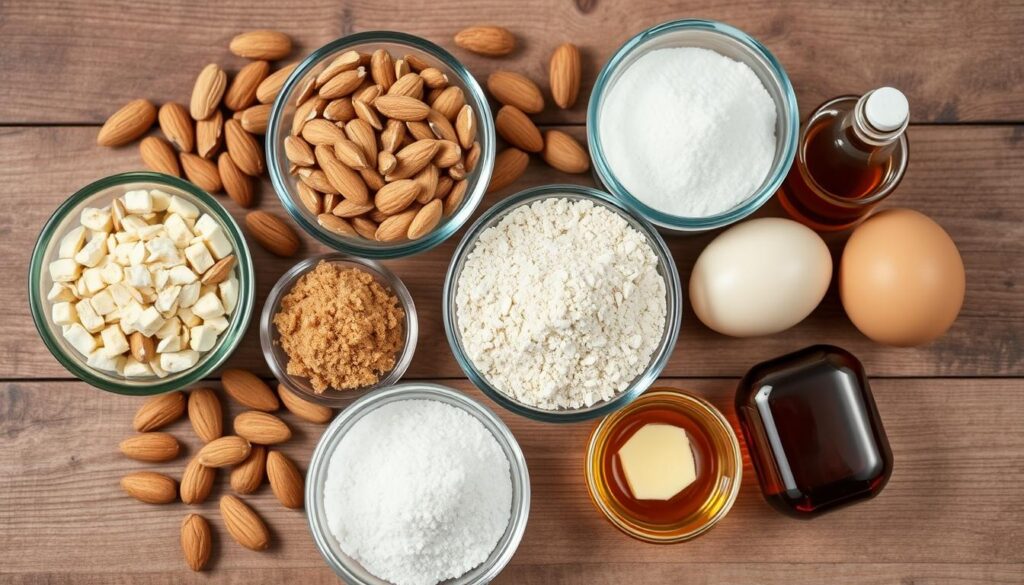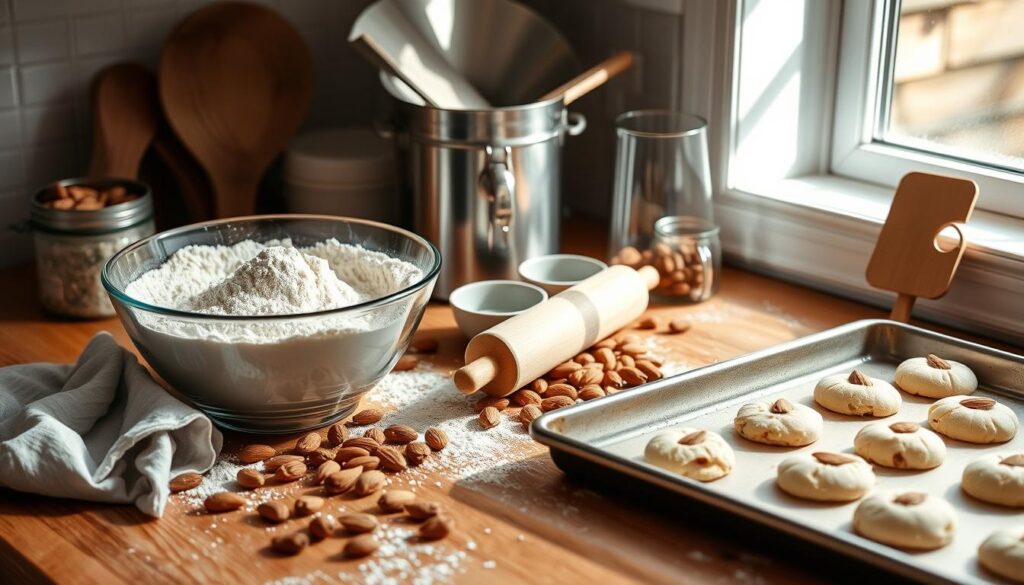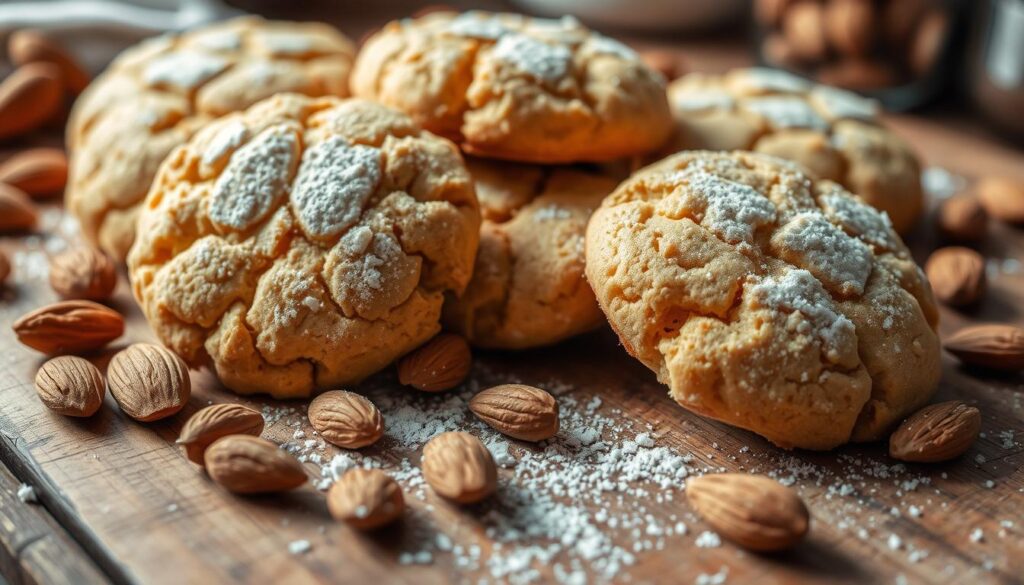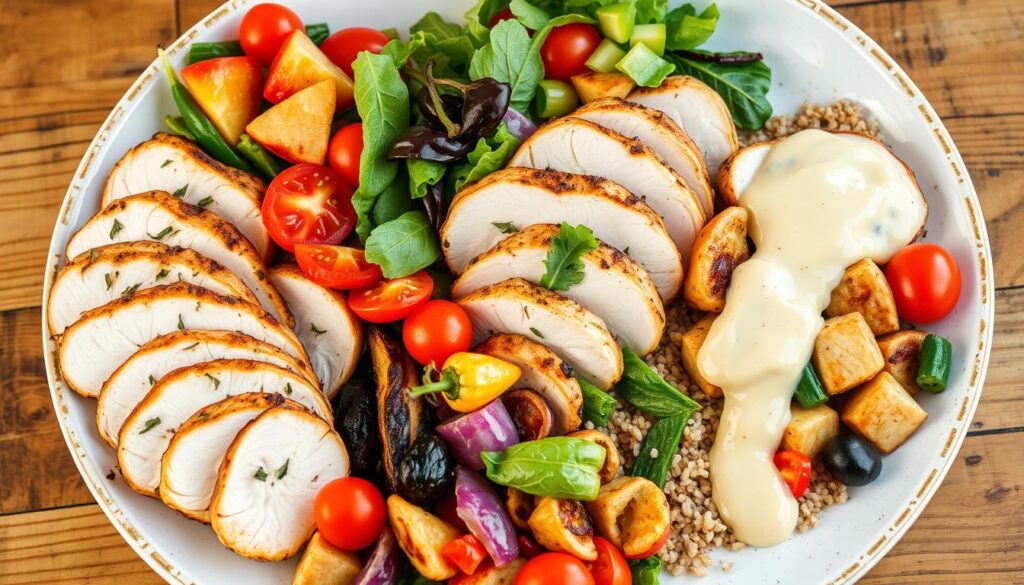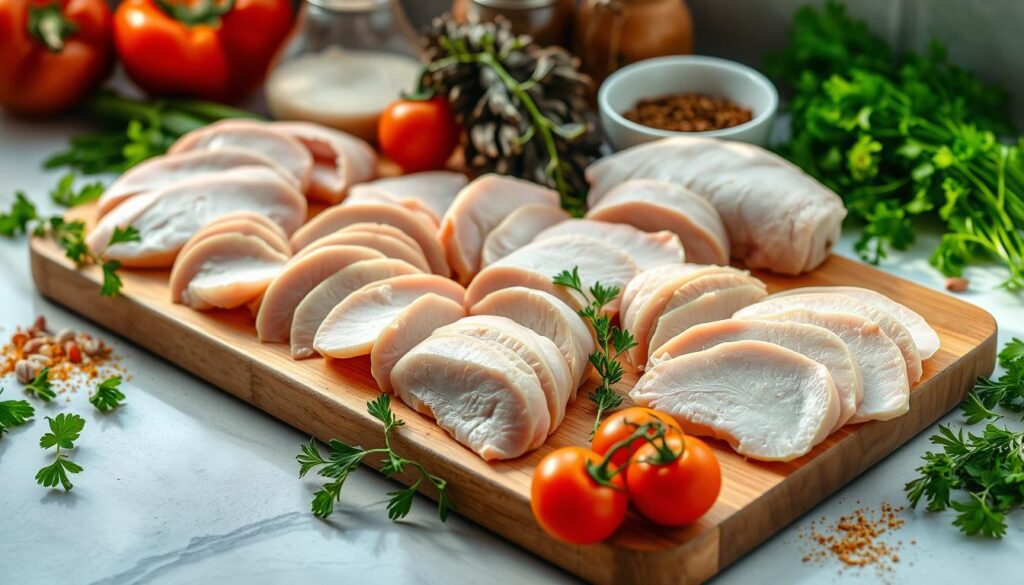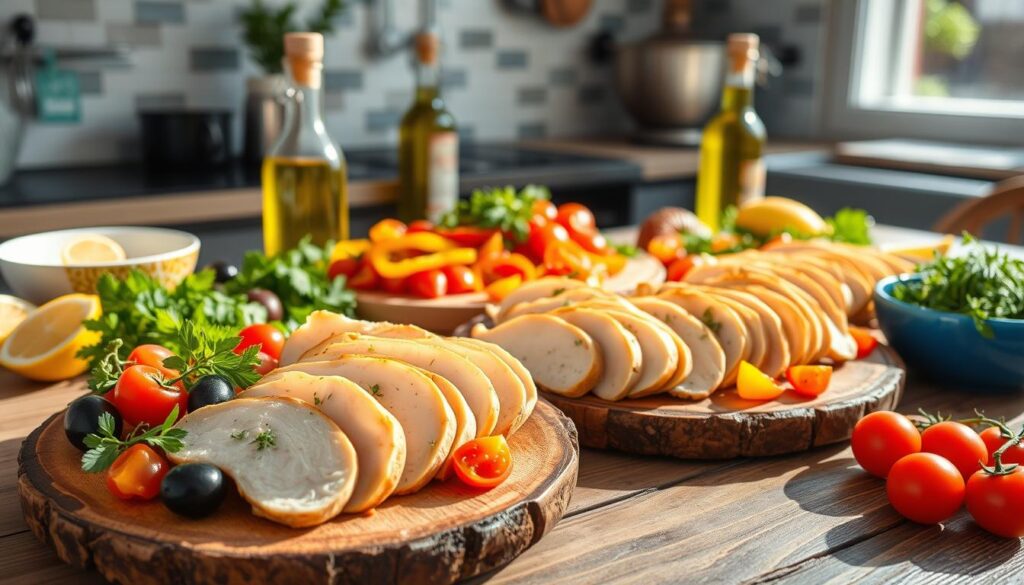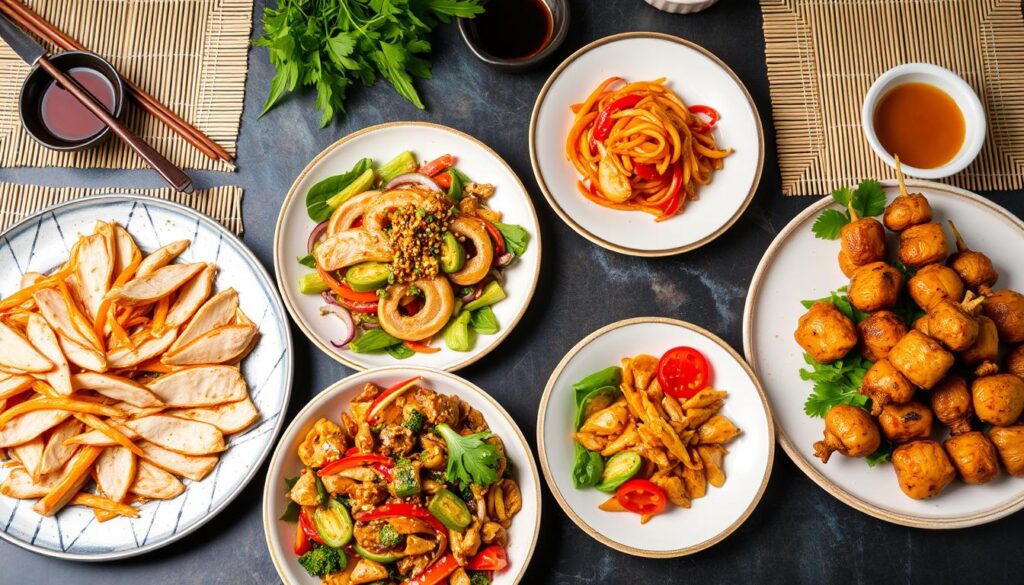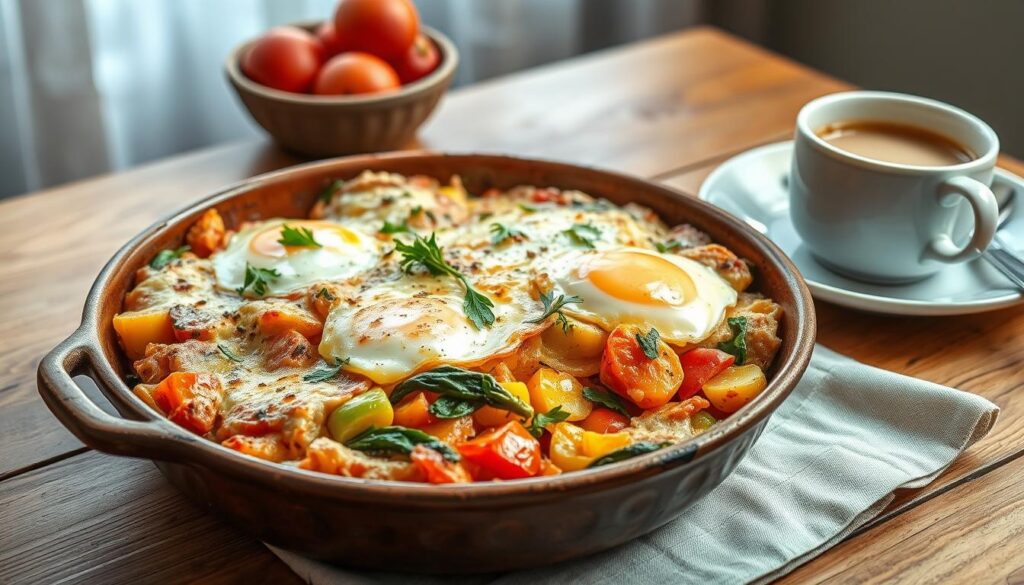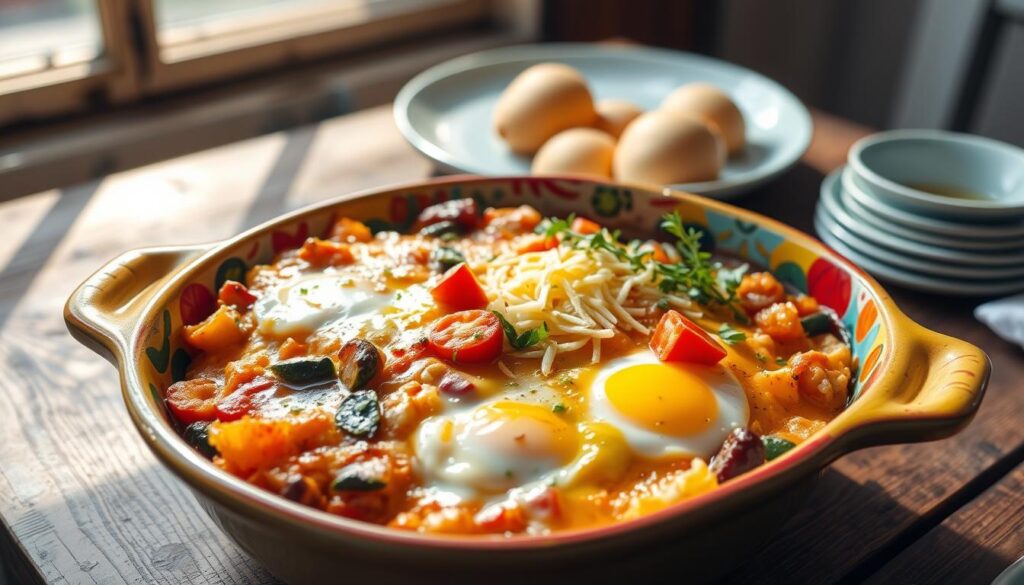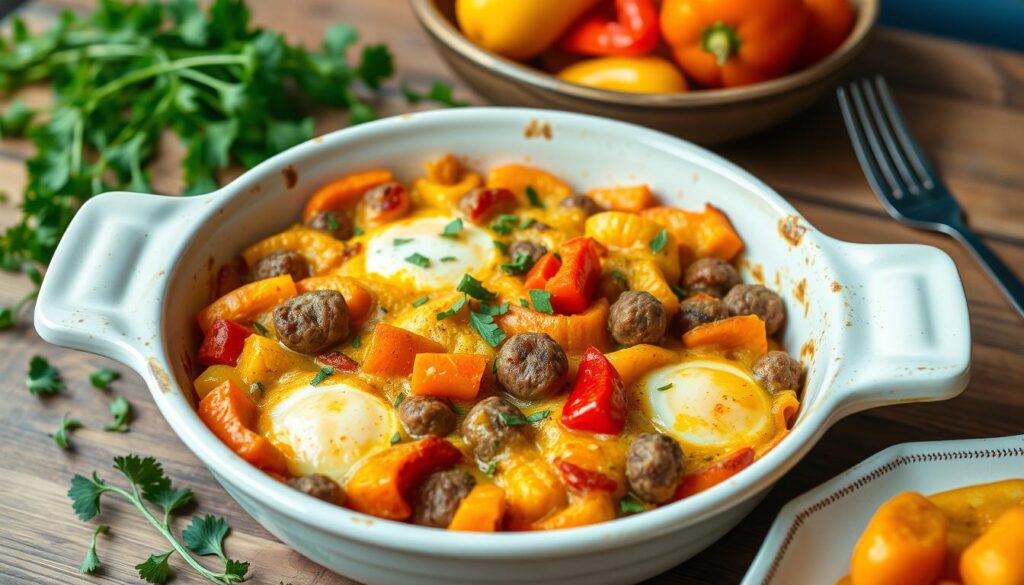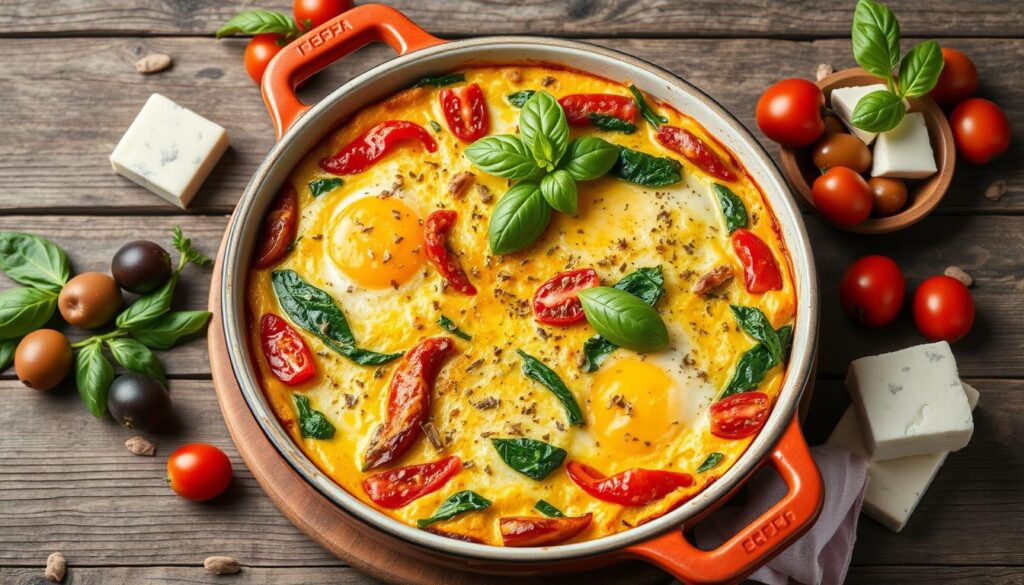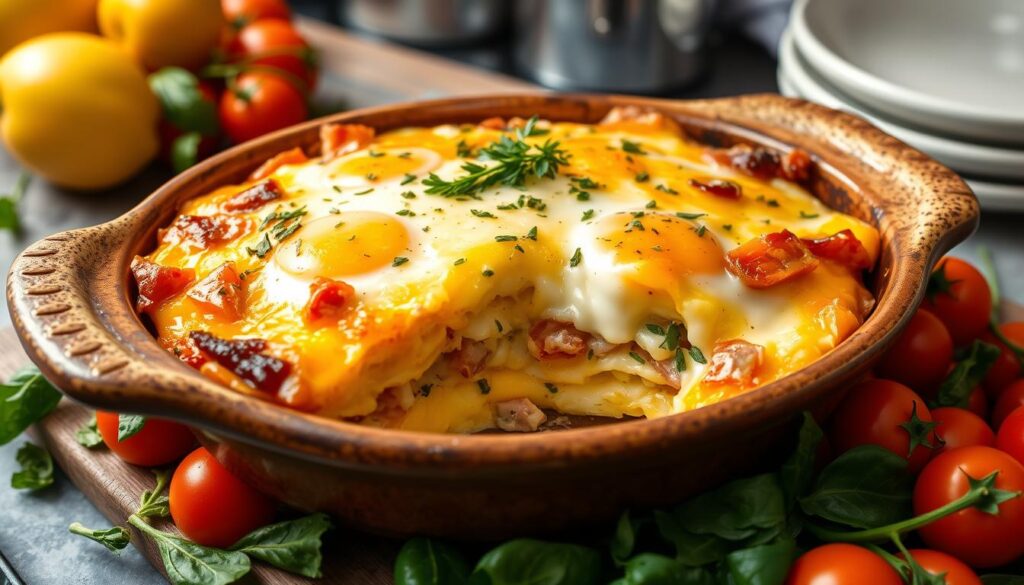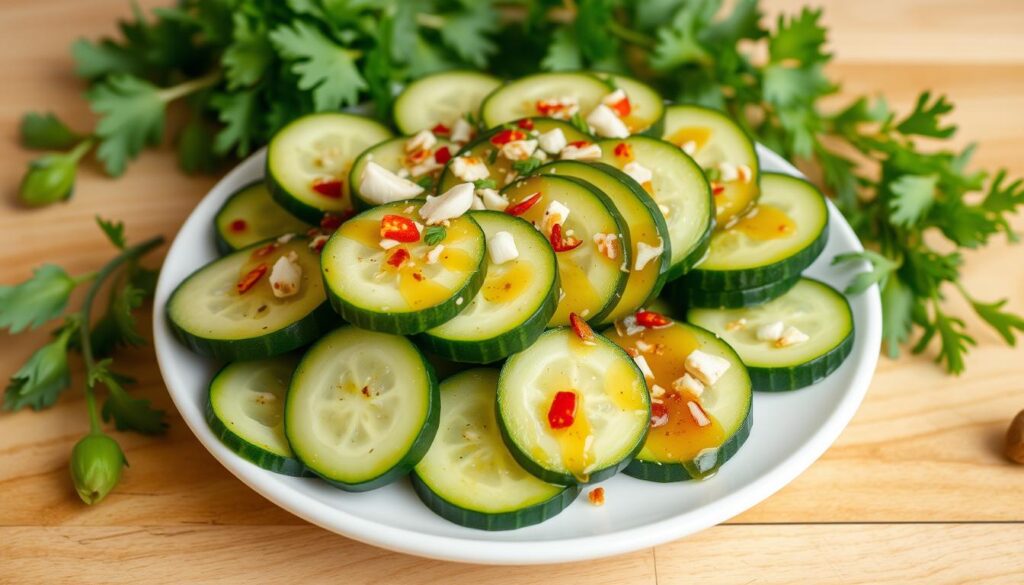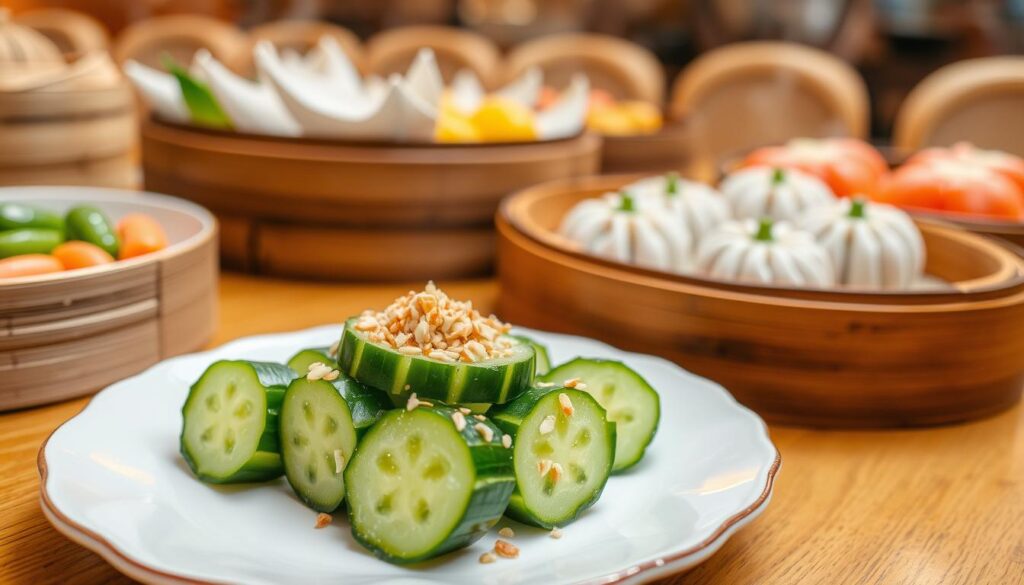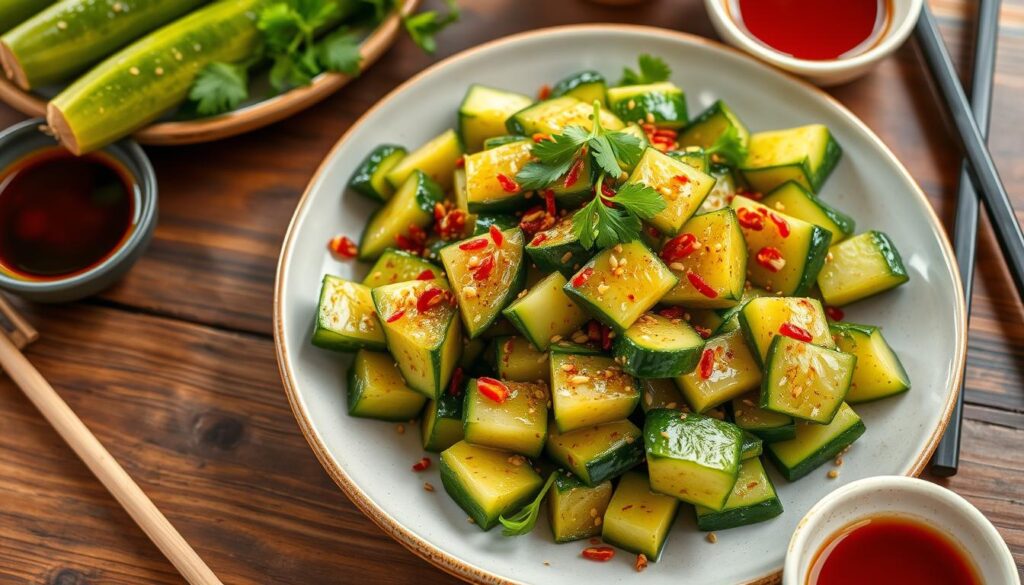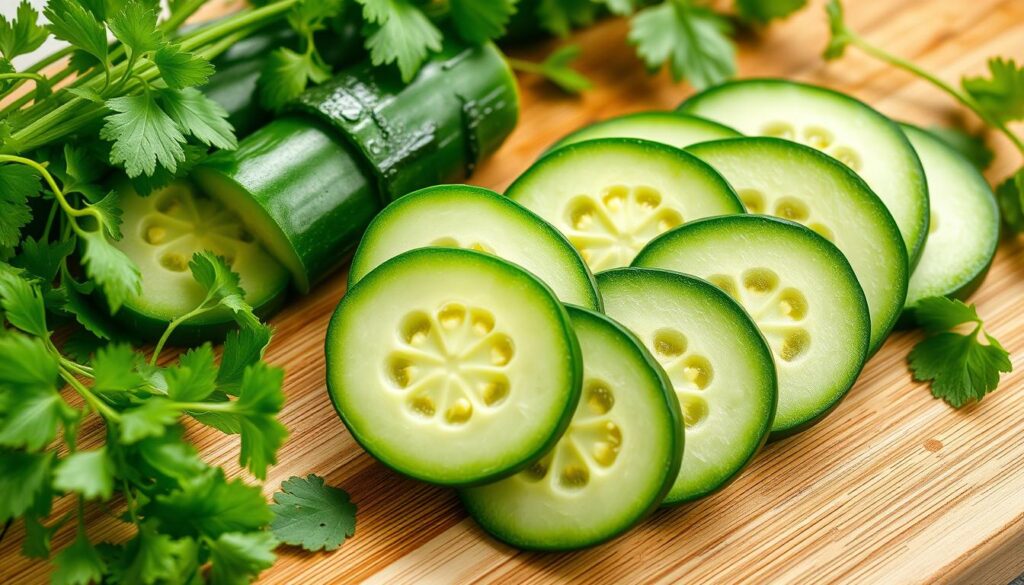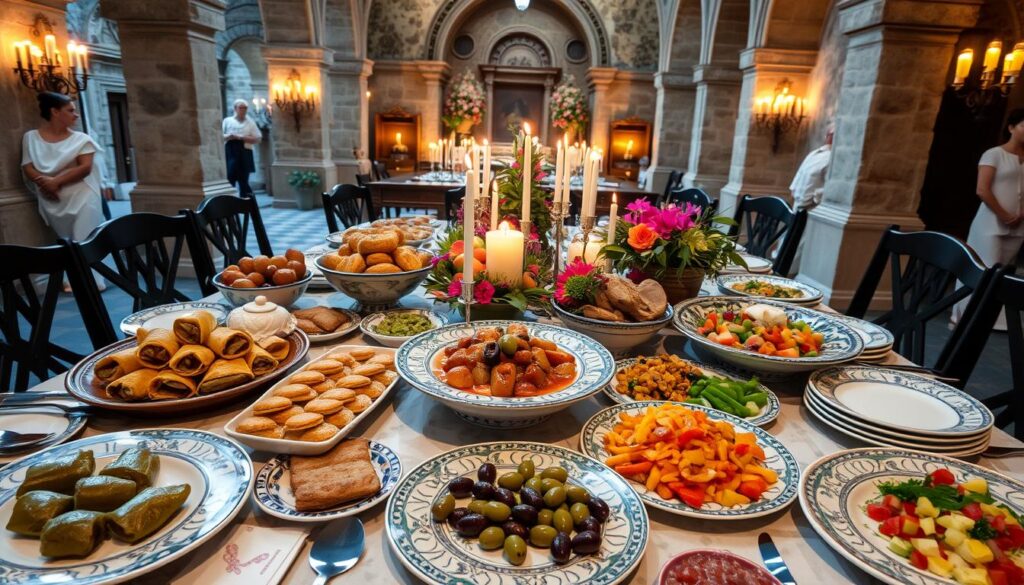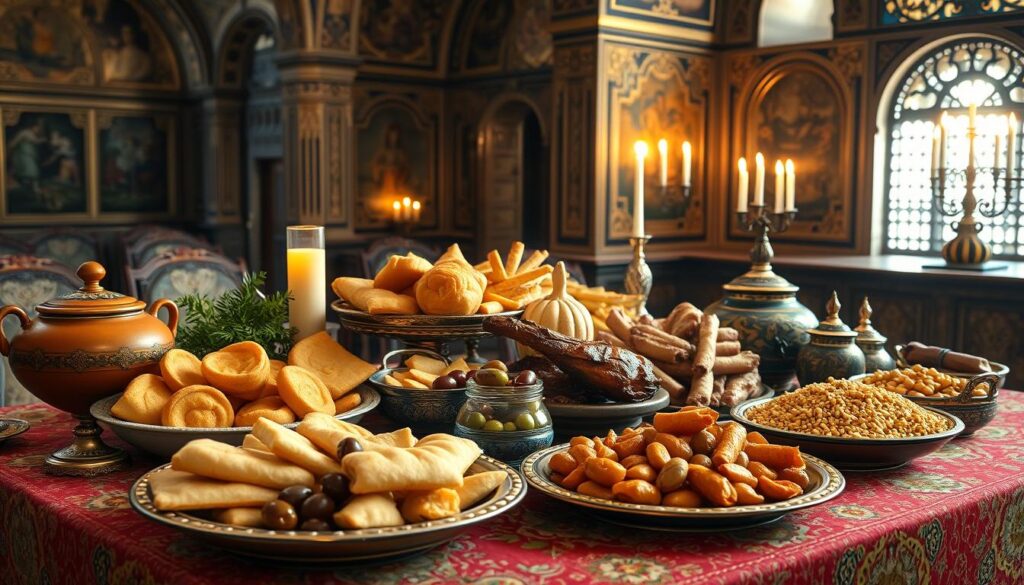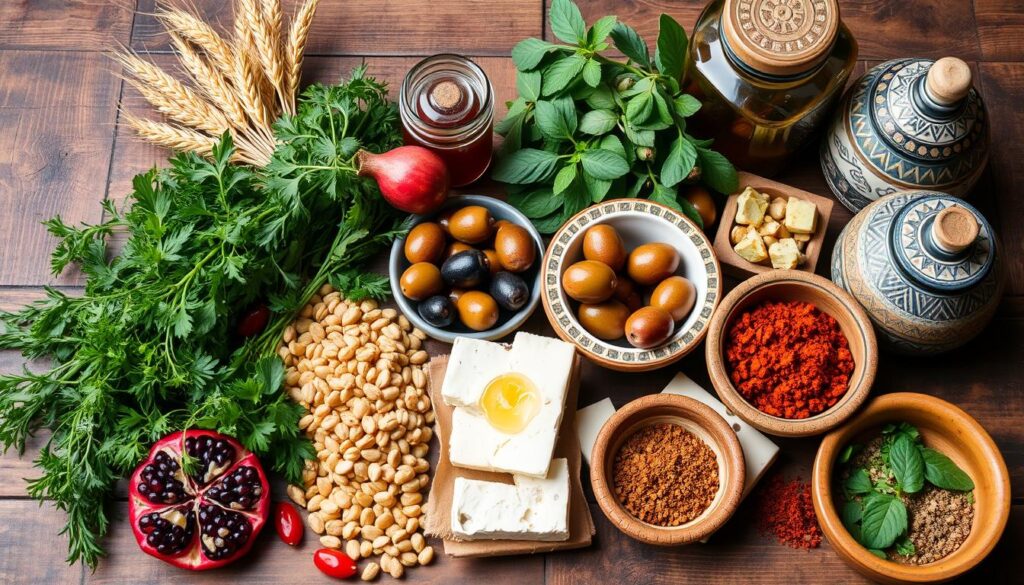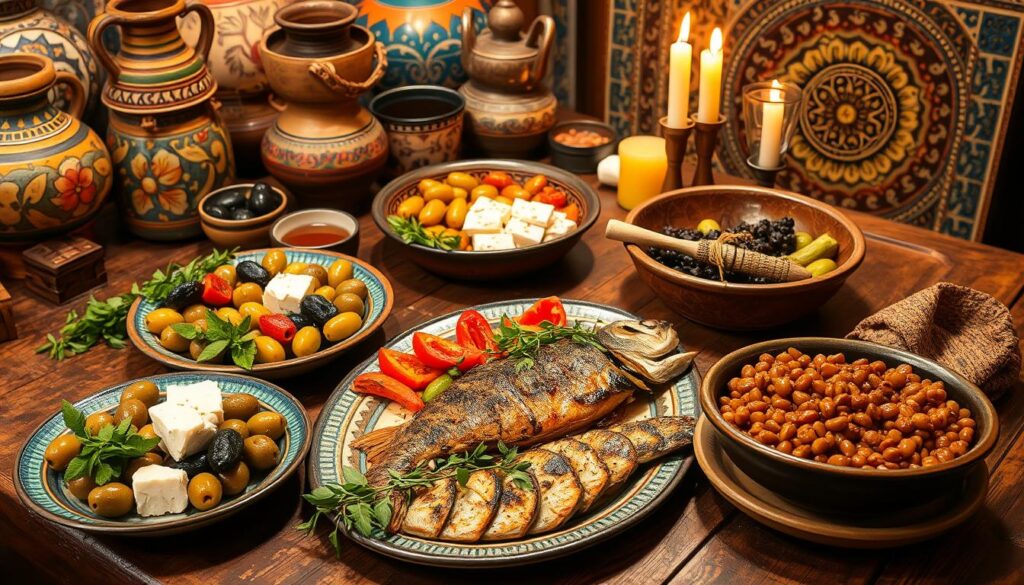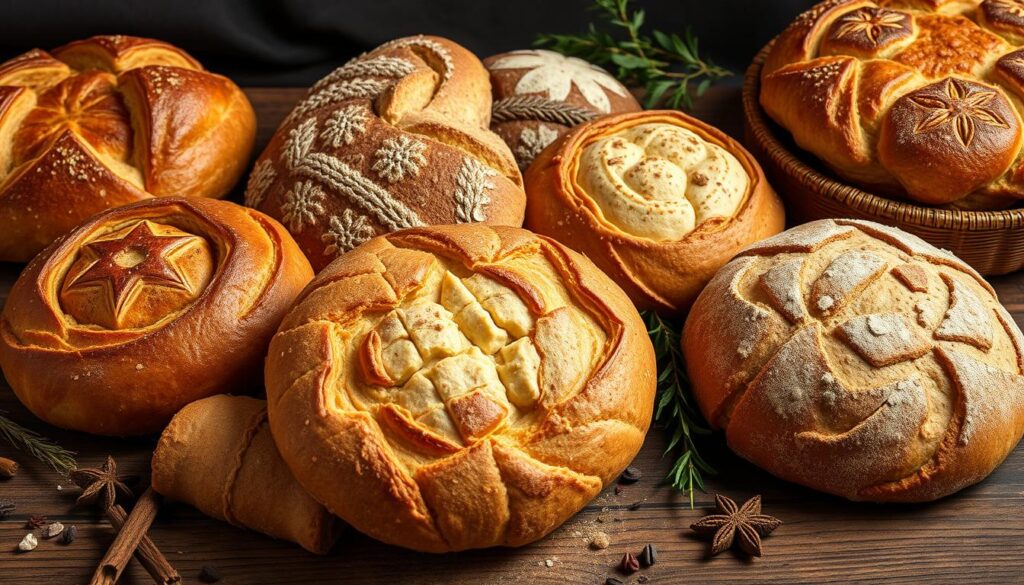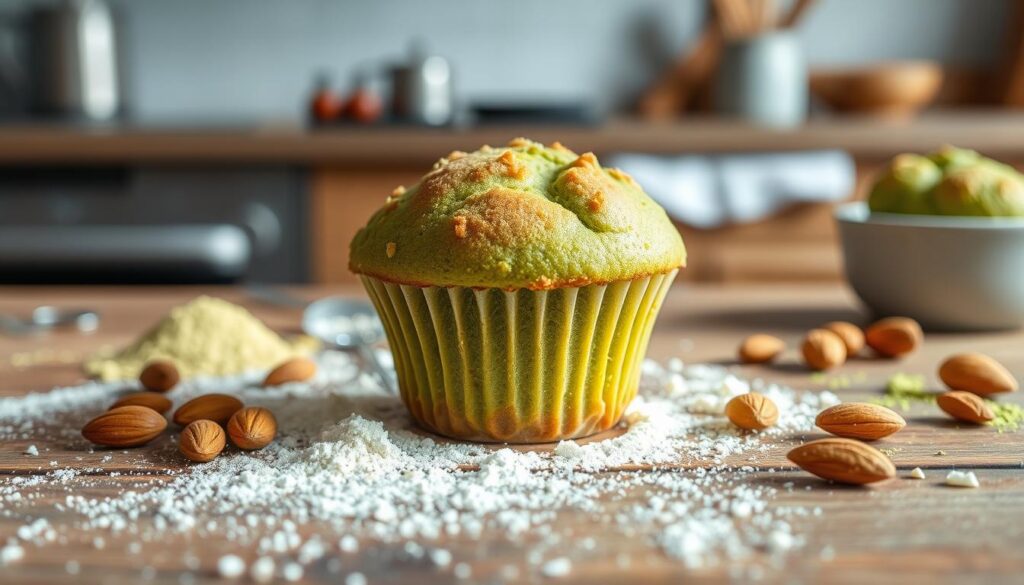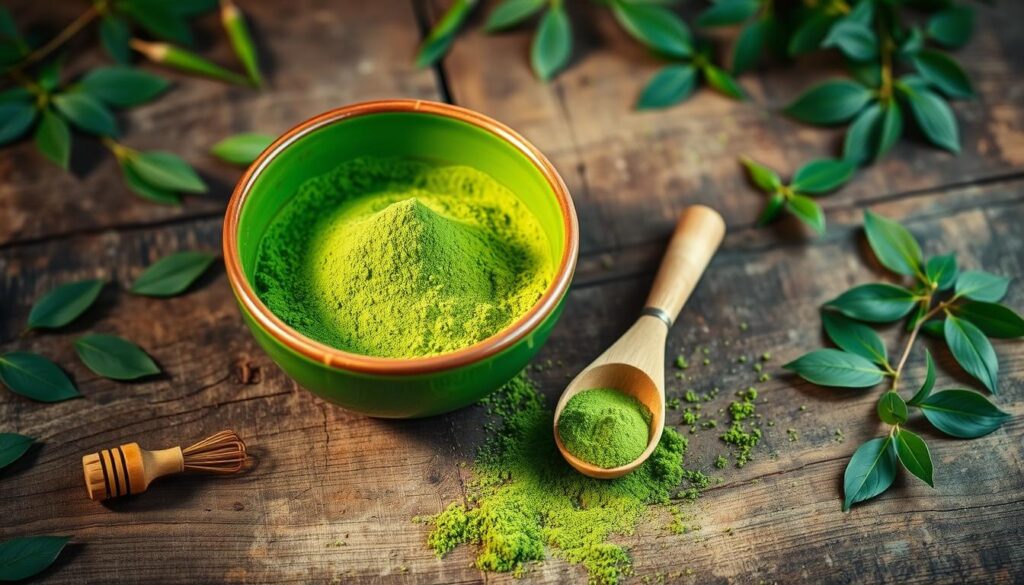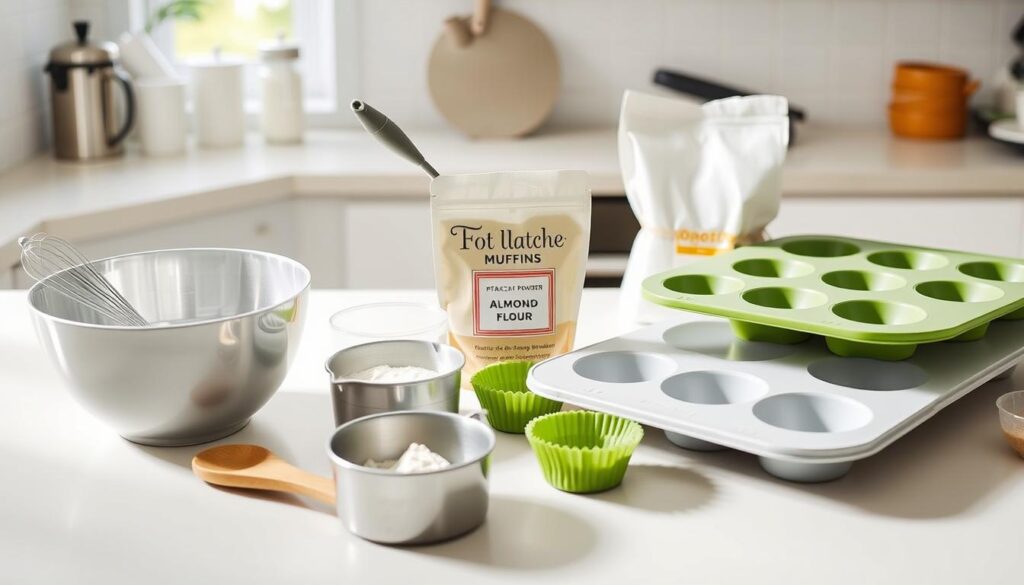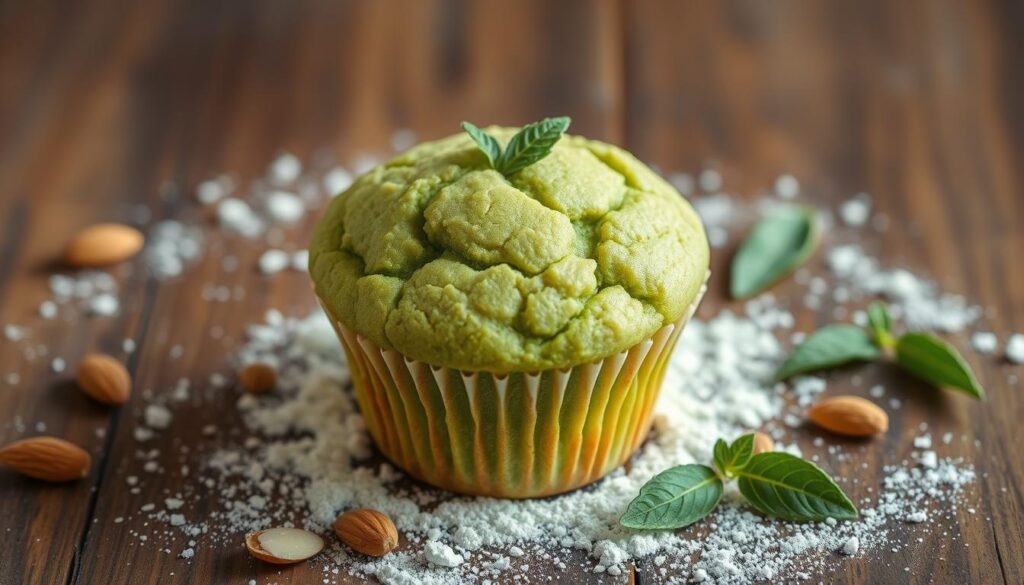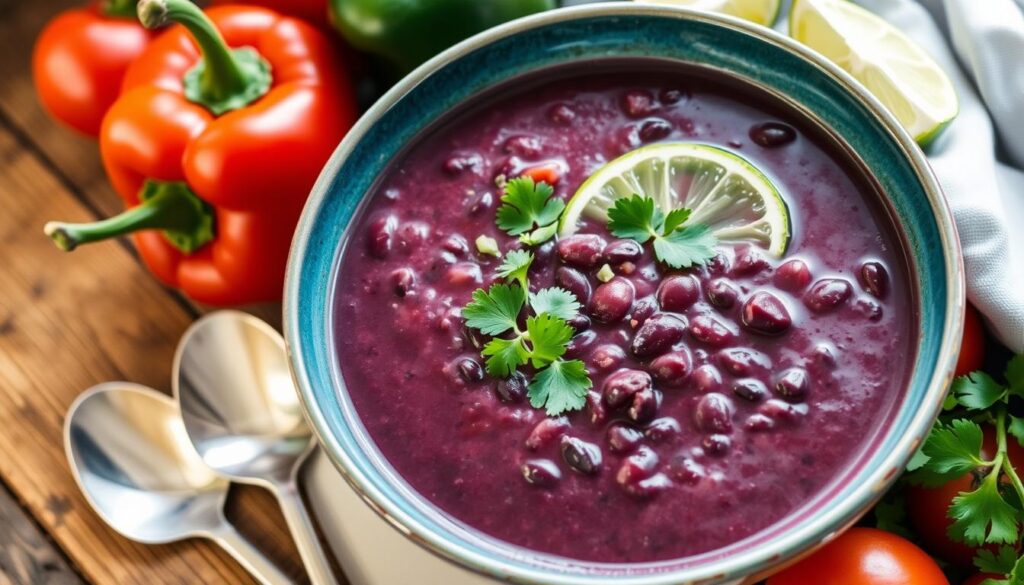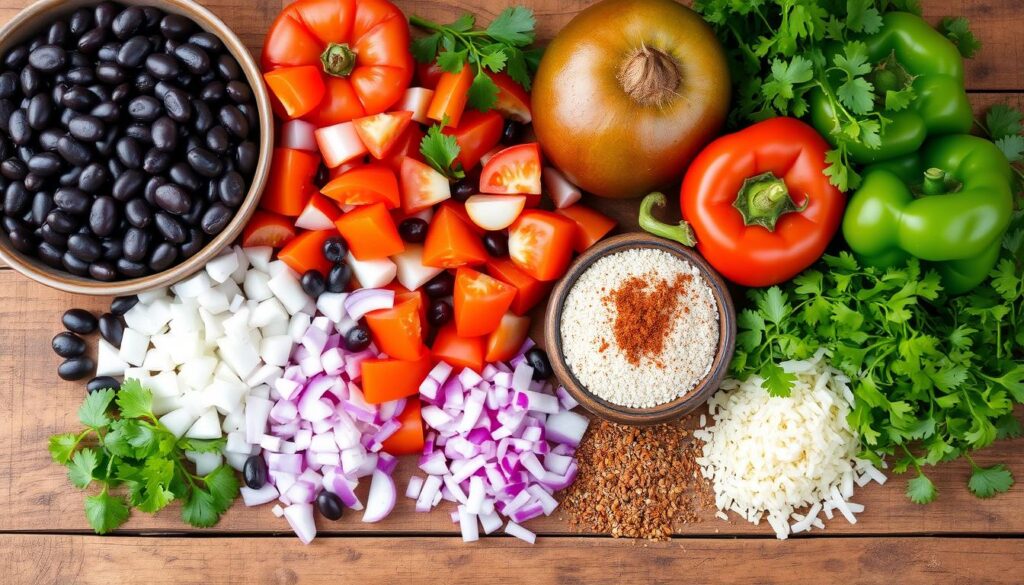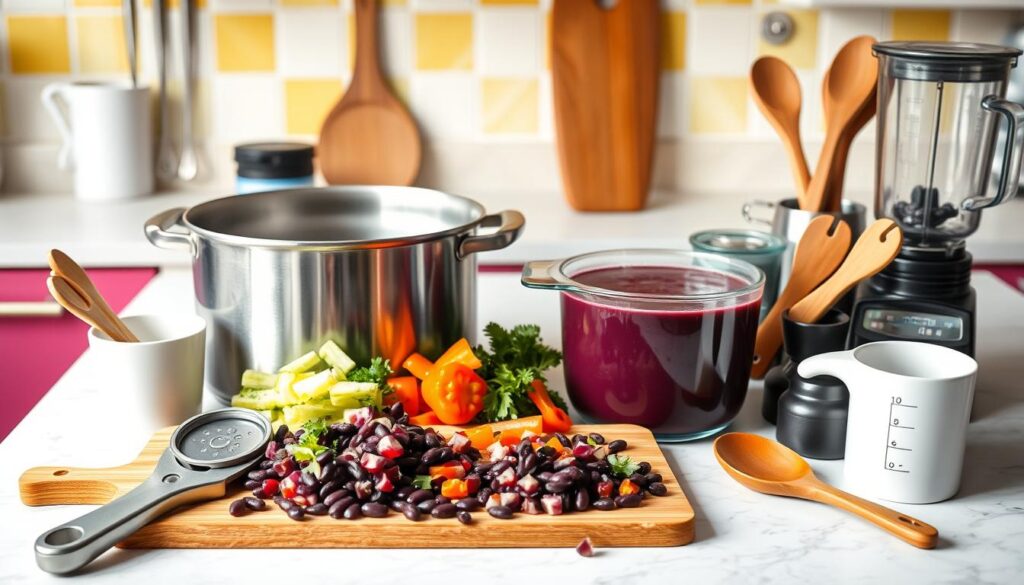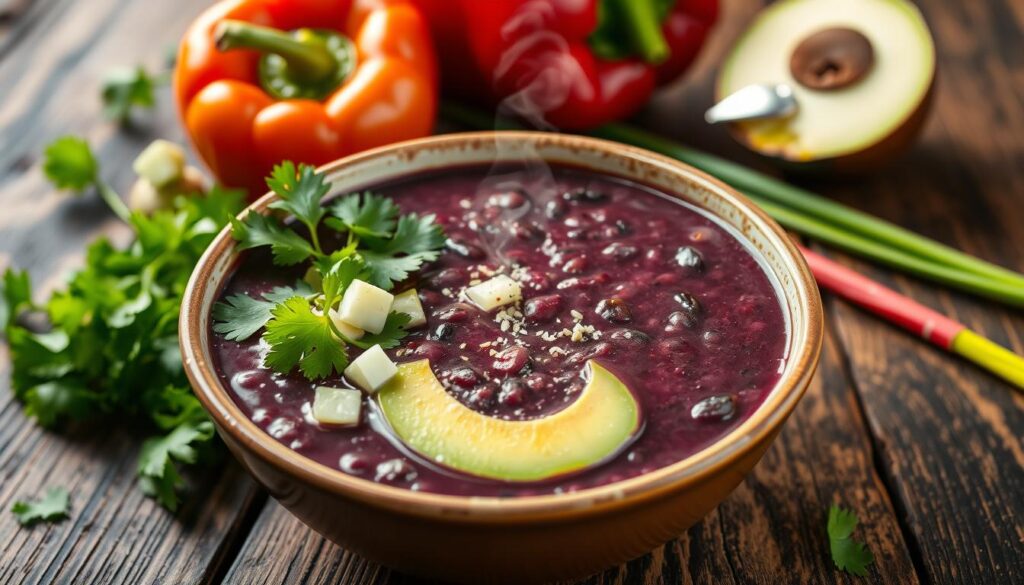I love cooking beef short ribs because of their rich flavors. The smell of slow-cooked meat with spices reminds me of my grandma’s kitchen. Her short ribs were tender and full of flavor, a true culinary delight.
In this guide, I’ll share how to make delicious cooking beef short ribs recipe seasoned with oxtail seasoning. It’s perfect for both experienced cooks and beginners. You’ll learn how to make braised short ribs and use oxtail spice blend. Your family and friends will love it so much, they’ll ask for more.
Table of Contents
Key Takeaways
- Discover the different cuts and quality grades of beef short ribs to ensure the perfect selection
- Understand the unique flavor profile of oxtail seasoning and how to incorporate it into your cooking
- Equip your kitchen with the essential tools and equipment for preparing tender, flavorful short ribs
- Learn the step-by-step process for trimming, seasoning, and cooking short ribs using various techniques
- Explore the nuances of braising vs. smoking to achieve your desired texture and flavor
Understanding Beef Short Ribs: Cuts and Quality Selection
When you’re cooking beef short ribs, knowing the cuts and quality is key. These ribs are tasty and can be cooked many ways, like in a slow cooker or on the barbecue. Let’s look at how to pick the best beef rib rub for your dish.
English-Cut vs. Flanken-Style Short Ribs
First, you need to decide on the short ribs cut. You can choose between English-cut and Flanken-style. English-cut ribs are thicker, with the bone along the meat. Flanken-style ribs are thinner, with the bone across the meat. Pick the cut that fits your slow cooker beef ribs or barbecue beef ribs recipe best.
Choosing Prime vs. Choice Grade
Next, think about the beef grade. Prime-grade ribs have more marbling, making them richer and more tender. Choice-grade ribs are also good, offering quality at a lower price. Your choice depends on your budget and taste.
Marbling and Thickness Considerations
Finally, consider the marbling and thickness of the ribs. More marbling means more flavor and juiciness. Thicker ribs take longer to cook but are meatier. Finding the right balance will make your beef rib rub stand out, whether you’re using a slow cooker or the barbecue.
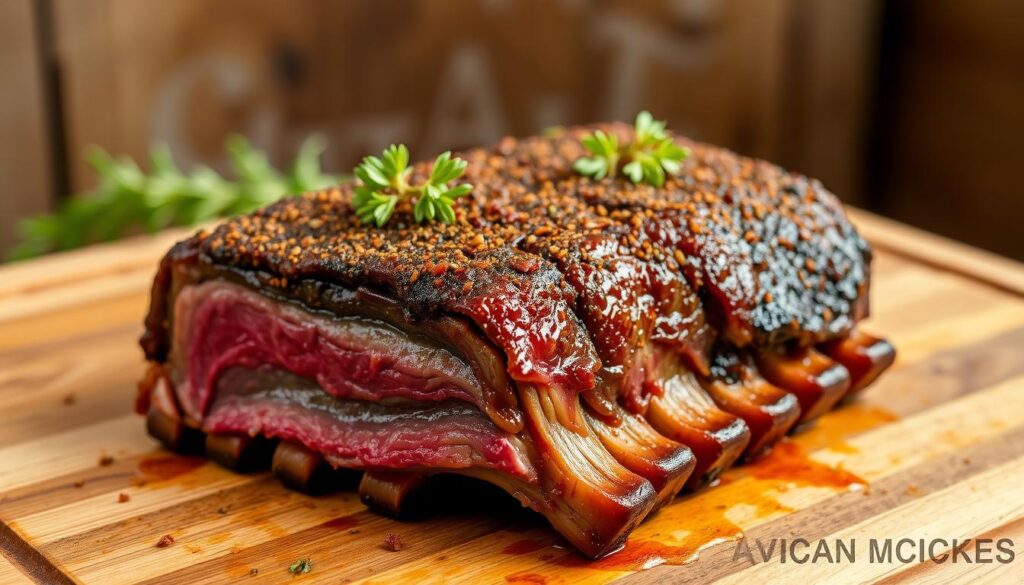
“The key to great short ribs is selecting the right cut and quality, which will set the stage for a mouthwatering dish.”
The Magic of Oxtail Seasoning: Flavor Profile and Ingredients
When you want to make your beef short ribs taste amazing, use jamaican oxtail seasoning. This special seasoning boosts the meat’s natural flavors. It also works well with different cooking ways, like braising or smoking.
The core of oxtail seasoning is a mix of earthy and aromatic spices. It usually has:
- Allspice, which adds a warm, slightly peppery taste
- Thyme, bringing a herbaceous depth
- Garlic, for a strong, savory flavor
- Onion, adding a hint of sweetness
- Paprika, for a smoky richness
- Black pepper, to add a subtle heat
While you can buy oxtail spice blends, making your own beef rib rub is better. You can adjust the flavors to match your taste and the beef short ribs you’re using.
“The secret to juicy, tender short ribs lies in the perfect seasoning blend. Oxtail seasoning is the key to unlocking their full flavor potential.”
Adding jamaican oxtail seasoning to your short ribs makes a big difference. Its complex yet balanced taste will take your dish to the next level. Every bite will be a joy for your taste buds.
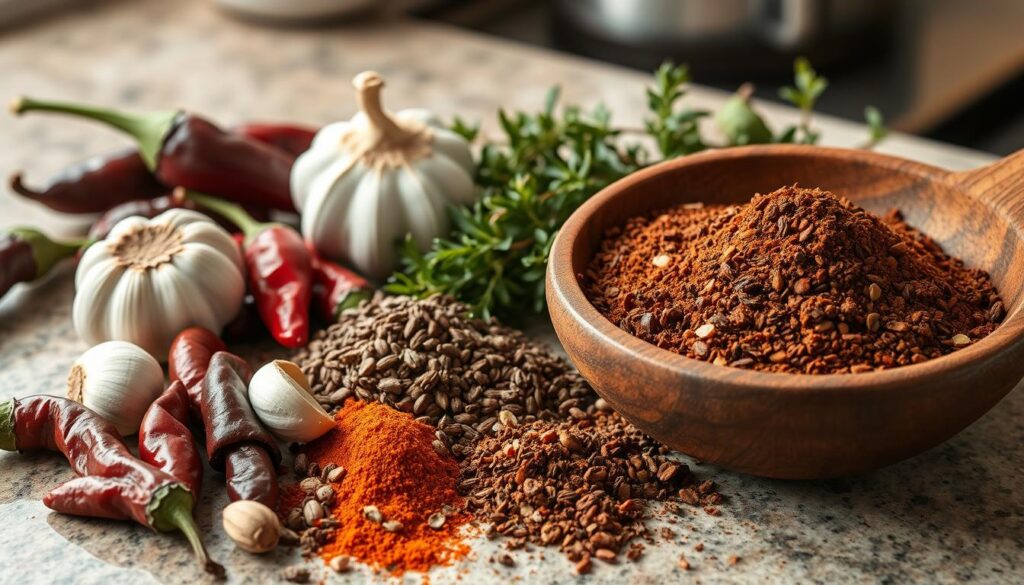
Essential Kitchen Tools and Equipment for Perfect Short Ribs
Preparing delicious slow cooker beef ribs or braised meat recipes needs the right tools. From the cooking pot to the temperature control, each tool is key. They help make your short ribs tender, flavorful, and perfectly cooked.
Recommended Cooking Vessels
For the best results, use a heavy-duty Dutch oven or a slow cooker. These pots keep heat and moisture in. This is important for braising tough beef short ribs until they’re tender.
- Dutch oven: A sturdy, enameled cast-iron pot that can withstand high temperatures and distribute heat evenly.
- Slow cooker: An electric appliance that simmers the meat at a low temperature for hours, resulting in incredibly tender and juicy short ribs.
Temperature Control Tools
Keeping the right temperature is key when cooking slow cooker beef ribs or braised meat. Get a reliable meat thermometer. It ensures your short ribs reach the perfect internal temperature for tenderness.
- Instant-read thermometer: Allows you to quickly check the temperature of the meat without losing too much heat from the oven or slow cooker.
- Oven-safe probe thermometer: Can be left in the meat during the cooking process, providing constant temperature monitoring.
Preparation Equipment
To trim and season your short ribs right, you’ll need these tools:
- Sharp boning knife: Allows you to trim away any excess fat and silver skin from the short ribs.
- Cutting board: Provides a stable surface for trimming and seasoning the meat.
- Mixing bowls: Useful for combining the oxtail seasoning or any other dry rubs or marinades.
With the right tools, you’ll make tender, flavorful slow cooker beef ribs or braised meat. Your family and friends will love them.
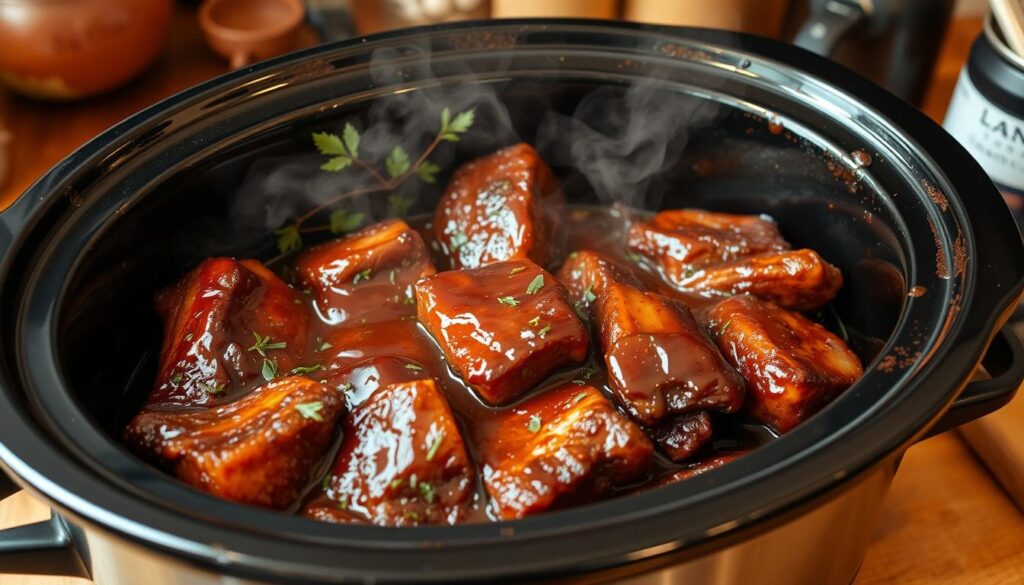
Cooking Beef Short Ribs Recipe Seasoned with Oxtail Seasoning
Try this amazing recipe for beef short ribs seasoned with oxtail seasoning. It works for braising, barbecuing, or slow cooking. You’ll get tender and tasty ribs every time.
First, trim the short ribs well to remove fat and silverskin. This makes them cook evenly and look better. Then, season the ribs with your homemade oxtail seasoning blend. Make sure to coat all sides.
- Preheat your oven, grill, or slow cooker to the right temperature for your cooking method.
- If braising, sear the seasoned ribs in a hot pan or Dutch oven until they get a nice crust on all sides.
- For barbecuing, put the ribs on a preheated grill. Rotate them often to get even browning.
- For slow cooking, just put the seasoned ribs in your slow cooker with your favorite braising liquid.
No matter how you cook, keep an eye on the ribs’ internal temperature. Braised short ribs should be 200-205°F. Barbecue beef ribs are best at 195-200°F.
“The secret to mouthwatering short ribs is in the seasoning and the cooking technique. This recipe delivers on both fronts for truly exceptional results.”
When your cooking beef short ribs recipe seasoned with oxtail seasoning is done, let the ribs rest for 10-15 minutes. This step makes sure the juices spread evenly. You’ll get a tender and flavorful bite every time.
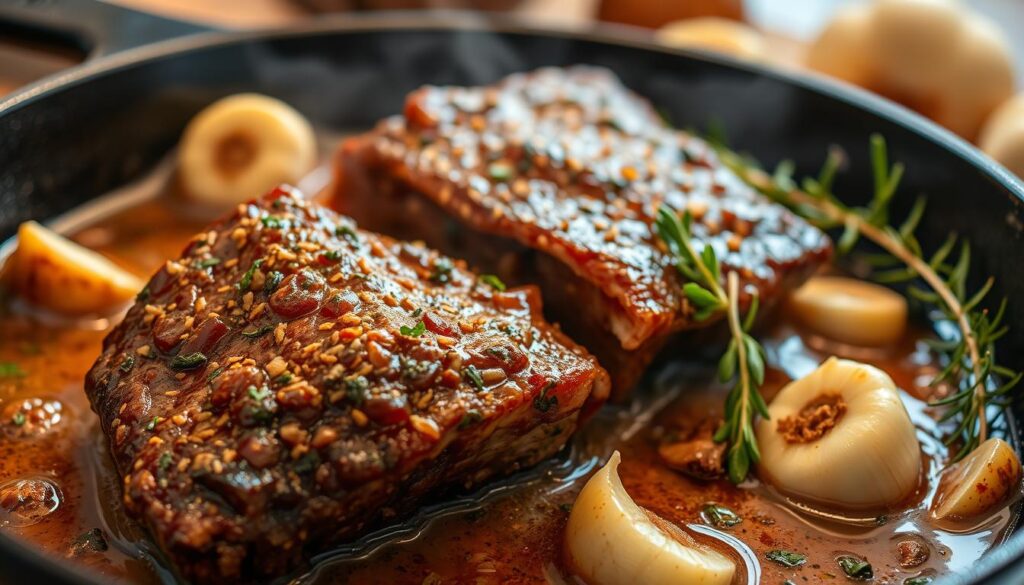
Preparation Techniques: Trimming and Seasoning
Take your beef short rib game to the next level by learning how to trim and season right. Use a beef rib rub, an oxtail spice blend, or a classic Jamaican oxtail seasoning. The secret to amazing flavor is in how you prepare.
Proper Trimming Methods
First, check your beef short ribs. Cut off any extra fat and silver skin for even cooking and a nice sear. Use a sharp knife to remove the tough membrane on the bone side. Be careful not to throw away any of the tender meat.
Seasoning Application Tips
- Coat the ribs well with your beef rib rub or oxtail spice blend. Make sure to cover all sides evenly.
- For a true Jamaican oxtail seasoning taste, add warm spices like allspice, thyme, and scotch bonnet peppers.
- Let the seasoned ribs sit at room temperature for 30 minutes before cooking. This lets the flavors mix well.
By using these prep methods, you’ll get tender, flavorful beef short ribs. Your guests will love them. Start cooking with these essential tips on trimming and seasoning.
Braising vs. Smoking: Choosing Your Cooking Method
When it comes to making delicious beef short ribs, you have two main choices: braising and smoking. Each method changes the meat’s texture and taste in different ways. Knowing the differences helps you pick the best method for your dish.
Braising short ribs is a traditional method. It involves searing the meat and then cooking it slowly in a flavorful liquid, like beef broth or red wine. This makes the ribs tender and full of flavor. The cooking liquid, or “braising sauce,” is also delicious.
Smoking beef ribs gives them a smoky taste and a tender texture. This method cooks the ribs over low heat and wood smoke for hours. It creates a unique, barbecue-style dish that’s great on its own or with sauce.
Think about what you want your ribs to taste and feel like. Braising is perfect for a rich, tender texture and intense beef flavor. Smoking is ideal for a smoky, barbecue-style rib with a juicy bite.
In the end, whether to choose braised short ribs or smoked beef ribs depends on your taste and the dining experience you want. Try both methods to see which one you like best and what your guests will enjoy.
“The key to delicious slow cooker beef ribs lies in the cooking method you choose – each one offers a unique set of flavors and textures to explore.”
Temperature and Timing Guidelines for Tender Results
To get the perfect texture and tenderness in your beef short ribs, you need to know the best internal temperatures and cooking times. Whether you’re braising, smoking, or slow-cooking, following these guidelines is key.
Internal Temperature Targets
For tender beef short ribs, aim for an internal temperature of 200-205°F. This ensures the meat is tender and falls off the bone. Keep an eye on the temperature as it rises slightly after removing from heat.
Cooking Duration by Method
- Braising: Cook the seasoned beef short ribs for 2-3 hours until they’re fork-tender and shred easily.
- Smoking: Smoking beef ribs takes 4-6 hours, depending on the ribs’ thickness and smoke flavor desired.
- Slow Cooking: In a slow cooker or oven, cooking the ribs for 6-8 hours will get them tender and ready.
The exact cooking time can change based on rib size, whether they’re bone-in or boneless, and your desired tenderness. Adjust the times as needed and use a meat thermometer for the best results.
Creating the Perfect Braising Liquid
Making the perfect braising liquid is crucial for delicious braised short ribs or other braised meat recipes. It’s all about mixing the right liquids, aromatics, and seasonings. This creates a rich, savory sauce that goes well with the oxtail spice blend on your beef.
Begin with a flavorful base like beef or chicken stock. This gives your braising liquid a strong start. Add a bit of red wine or balsamic vinegar for depth and complexity. Onions, garlic, and herbs can also boost the flavor.
To finish the braising liquid, include these important elements:
- Tomato paste or crushed tomatoes for richness and a bit of acidity
- Worcestershire sauce or soy sauce for a savory umami taste
- Brown sugar or honey to balance the flavors
- Your special oxtail spice blend to bring everything together
Remember to taste and adjust the seasoning as you go. This ensures the braising liquid complements the bold taste of your braised short ribs. With a bit of practice, you’ll get great at making the perfect braising liquid for your dishes.
Resting and Serving Your Short Ribs
After cooking, whether braising or smoking, it’s key to let the meat rest. This step is vital for keeping your short ribs juicy and tender.
Proper Resting Techniques
Move the short ribs to a cutting board or clean surface once they’re done. Cover them loosely with foil or a towel. This keeps the meat warm and lets juices spread evenly.
Let the ribs rest for 10 to 15 minutes, depending on their size. This time helps the meat relax and juices settle, making it more flavorful and tender.
Presentation Tips
When serving your short ribs, consider these presentation ideas:
- Place the ribs on a large platter or cutting board, making sure they look neat.
- Add fresh herbs like rosemary or thyme for color and scent.
- Drizzle braising liquid or homemade barbecue sauce for extra flavor and moisture.
- Pair the ribs with side dishes like mashed potatoes or roasted veggies for a balanced meal.
By following these tips, you’ll enjoy your cooking beef short ribs recipe seasoned with oxtail seasoning or barbecue beef ribs to the fullest.
Wine Pairing and Side Dish Recommendations
Enjoying oxtail-seasoned braised, smoked, or barbecue beef short ribs is even better with the right wine and side dishes. Choose a bold, full-bodied red wine to match the rich flavors of your short ribs. A Cabernet Sauvignon or Malbec is perfect, with their tannins and fruity notes balancing the meat’s richness.
For side dishes, pick items that complement the short ribs’ seasoning and cooking method. Braised short ribs go well with creamy mashed potatoes or a hearty root vegetable medley. Smoked beef ribs pair nicely with tangy coleslaw or roasted Brussels sprouts. Barbecue beef ribs are great with classic baked beans or a fresh, vinegar-based slaw.
Creating a harmonious meal means choosing flavors and textures that enhance the experience. By carefully picking your wine and side dishes, your oxtail-seasoned beef short ribs will be a hit in every bite.
FAQ
What is the difference between English-cut and Flanken-style short ribs?
English-cut short ribs are cut across the bone, making thick, individual pieces. Flanken-style ribs are cut parallel to the bone, making them thinner and strip-like.
How do I choose the best quality beef short ribs?
Look for Prime or Choice grade ribs for more marbling and flavor. Thicker ribs might need longer cooking times.
What is the flavor profile of oxtail seasoning, and how does it complement beef short ribs?
Oxtail seasoning has warm spices like garlic and onion, and herbs like thyme. It enhances the beefiness of short ribs, adding depth to the flavor.
What kitchen tools and equipment are essential for cooking perfect beef short ribs?
You’ll need a Dutch oven or slow cooker, a meat thermometer, and tools for trimming and seasoning. A sharp knife and spice grinder are helpful.
How do I properly trim and season beef short ribs with oxtail seasoning?
Trim excess fat and silver skin first. Then, coat the ribs evenly with oxtail seasoning. Let them rest for 30 minutes before cooking.
Should I braise or smoke my oxtail-seasoned beef short ribs?
Braising makes the meat tender, while smoking adds a smoky flavor. Choose based on your preference and desired texture.
What are the optimal internal temperature and cooking times for tender beef short ribs?
Aim for an internal temperature of 200-205°F. Braising takes 2-3 hours, while smoking or slow-cooking can take 4-6 hours.
How do I create the perfect braising liquid for oxtail-seasoned short ribs?
Use beef or chicken stock as a base. Add onions, garlic, and herbs, along with wine or tomatoes, and a bit of sweetness from brown sugar or honey.
How should I rest and serve my oxtail-seasoned beef short ribs?
Let the ribs rest for 10-15 minutes after cooking. This makes them tender and juicy. Serve with braising liquid and garnish with fresh herbs or oxtail seasoning.
What wine pairings and side dishes complement oxtail-seasoned beef short ribs?
Full-bodied red wines like Cabernet Sauvignon pair well with the ribs. Side dishes like creamy mashed potatoes or roasted vegetables balance the meat’s richness.

